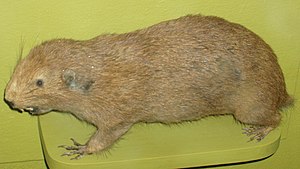Stumptail squirrel
| Stumptail squirrel | ||||||||||||
|---|---|---|---|---|---|---|---|---|---|---|---|---|

Stubby- tailed squirrel ( Aplodontia rufa ) |
||||||||||||
| Systematics | ||||||||||||
|
||||||||||||
| Scientific name of the family | ||||||||||||
| Aplodontiidae | ||||||||||||
| Brandt , 1855 | ||||||||||||
| Scientific name of the genus | ||||||||||||
| Aplodontia | ||||||||||||
| Richardson , 1829 | ||||||||||||
| Scientific name of the species | ||||||||||||
| Aplodontia rufa | ||||||||||||
| ( Rafinesque , 1817) |
The stumpy- tailed squirrel or beaver squirrel ( Aplodontia rufa ) is a primitive rodent from North America . The name “mountain beaver”, which is transferred from the English name “mountain beaver”, is often used for this animal; however, they are not closely related to beavers .
features
The stump tail squirrel is reminiscent of a muskrat without a tail. It is stocky and cylindrical in shape and has very short limbs. Ears and eyes are tiny and almost hidden in the fur. The head body length is about 40 cm, the tail, which is only 2 cm short, is hardly visible. With a weight of 800 g (exceptionally up to 1.8 kg), the stubby-tailed squirrel is a relatively heavy rodent.
The coat is grayish brown to reddish brown in color and consists of short hairs. The animals get darker with age.
distribution and habitat
The distribution area stretches in a strip over the extreme west of North America, which extends from southern British Columbia to central California . Despite the English name "Mountain Beaver", it avoids the heights of the Rocky Mountains and is more common in lower elevations. The habitat are forests, in which the stubby-tailed squirrel finds dense undergrowth to hide. The proximity of water is a prerequisite; the burrows are found on river banks or in swamps.
Way of life
In the damp earth of the swampy habitat, the stubby-tailed squirrel builds its tunnels, which are about 20 cm in diameter. Several passageways lead from a central chamber to the openings where food sources are found. The animal always stays near an entrance. The corridors are regularly cleaned and expanded. Over time, this also creates dead areas of the duct system that are used by other animals such as rabbits and red squirrels . Stubby-tailed squirrels do not hibernate, but store food supplies for the winter. They are diurnal and nocturnal.
The diet consists of all kinds of green plant material. Only when food is scarce in winter will it eat branches and bark if necessary. To get to leaves, it climbs into shrubs and small trees; it rises from branch to branch, but cannot climb up a trunk.
Stubby-tailed squirrels have poor eyesight, but sharp hearing and a good sense of touch.
Stubby-tailed squirrels are solitary creatures who defend their burrows from other species. Between January and March, couples get together for a short time and separate immediately after mating. After a gestation period of thirty days, two or three young are born. The eyes of the young remain closed for the first fifty days of life. They are suckled for eight weeks and do not leave the nest during this time. They only reach full size and sexual maturity at the age of two. The lifespan is five to six years.
Stubby squirrels and humans
Because it lives in swamps, the damage done by stubby squirrels in agriculture is minimal. However, they are said to damage the shoots of young trees in the event of a population accumulation.
Conversely, in some regions stubby squirrels are becoming very rare due to the drainage of their habitats. Two subspecies are now classified as endangered by the IUCN : the Point Arena stubby squirrel ( A. r. Nigra ) from Mendocino County, California and the Point Reyes stubby squirrel ( A. r. Phaea ) from the San Bay area Francisco .
Systematics and evolution
The stubby-tailed squirrel has no close relatives among living rodents. It is often viewed as a particularly primitive member of the rodent family, and fossil members of the Aplodontiidae family are actually known from the Eocene . The family probably originated in North America and spread to Eurasia during the Oligocene and Miocene , where it disappeared again before the beginning of the Pliocene . The stumptail squirrel is the last survivor of this family.
Some families from the relationship of the Aplodontiidae have been fossilized: The Ischyromyidae (formerly Paramyidae) already appeared in the Paleocene and are the oldest known representatives of rodents. They were very species-rich until the Eocene. Other families that peaked in the Miocene were the Allomyidae and the Mylagaulidae. The latter were characterized by horn formations on the nose. All together, these families are grouped together to form a taxon called Protrogomorpha, which is found at the base of the rodents.
| Protrogomorpha |
|
||||||||||||||||||
|
|
Others
A parasite of the stubby squirrel, Hystrichopsylla schefferi , is the largest flea in the world with a length of 9 mm .
In the language of the Chinook - Indians called the mountain beaver Sewellel - a name found in English-language literature increasingly widespread. The Chinook used the animal's fur to make clothing.
The scientific name Aplodontia means something like "simply toothed".
literature
- Leslie N. Caraway, BJ Verts: Aplodontia rufa . In: Mammalian Species . tape 431 , 1993, pp. 1–10 ( full text (PDF)).
- Ronald M. Nowak: Walker's Mammals of the World. 2 volumes. 6th edition. Johns Hopkins University Press, Baltimore MD et al. 1999, ISBN 0-8018-5789-9 .
- Malcolm C. McKenna, Susan K. Bell: Classification of Mammals. Revised Edition. Above the species level. Columbia University Press, New York NY 2000, ISBN 0-231-11013-8 .
Web links
- Aplodontia rufa in the endangered Red List species the IUCN 2006. Posted by: Steele, 2000. Retrieved on 11 May, 2006.

